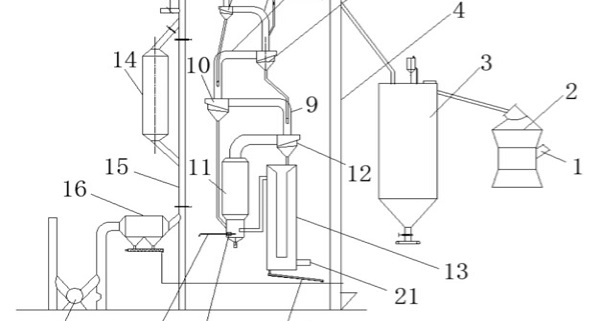The main difference between active lime and ordinary lime is the activity of lime. When steel mill smelts steel, adding active lime can greatly improve the smelting efficiency of steel. In view of the increasing demand for active lime in the market and the large gap in the market, lime production enterprises gradually begin to adopt professional lime kilns and processes to produce active lime. But in the process of active lime production, there are many problems one after another. If these problems can not be solved in time, the quality of active lime will be greatly affected. Let’s understand the production process of active lime and some problems needing attention in the calcination process, and reveal some unknown secrets in the process of active lime production for you.
The raw materials used for producing active lime are mainly carbonate rocks. The element composition is mainly CaCO3, which is what we usually call limestone. There are many kinds of limestone, such as granular crystalline limestone, compact limestone, porous limestone, earthy limestone, marl limestone, chalk, dolomite, shell limestone River pebble and so on. Because of the high requirement of calcium oxide content in the main chemical composition of active lime, it should generally reach more than 90%. At the same time, the lower the content of sulfur, phosphorus and other impurities, the better the requirements.
Therefore, the quality of raw limestone for the production of active lime is clearly required. In the selection and use of lime raw materials, among many grade limestone, limestone with calcium oxide content greater than 54%, low impurity content such as silicon dioxide, sulfur, phosphorus, magnesium oxide, ferric oxide and aluminium oxide is often used as raw material for calcining active lime. Because it is the primary guarantee to realize the physical and chemical properties of active lime products, this is very important.
The influence of calcining equipment on lime activity depends largely on the calcining equipment used for calcining limestone. According to the structure of the kiln, the lime kiln can be roughly divided into ordinary shaft kiln, parallel flow regenerative shaft kiln, sleeve shaft kiln, rotary kiln and fluidized bed kiln.
Common shaft kiln can not produce high active lime because of the following reasons: 1) uneven distribution of air flow in the cross section of shaft kiln, different speed of material moving downward, large temperature difference on the same cross section, forming local high-temperature zone and low-temperature zone, resulting in uneven calcination degree of lime and poor activity of lime; 2) long residence time of limestone in kiln, generally about 20-45 hours, resulting in rearrangement of lime crystal lattices and increase of grain size. As a result, inactive lime with low reactivity is produced. 3. Coke and coal are commonly used as raw materials in lime shaft kilns in China, because ash generated by coke and coal residues in lime, resulting in an increase in lime impurities.
Rotary kiln can forge lime with high activity. The reasons are as follows: 1. Radiation heat transfer is the main heat transfer in the rotary volume, while conduction heat transfer is the main heat transfer in the lime layer. Through the continuous rotation of the kiln body, the material is continuously mixed and homogenized. During the rolling process, the large particles in the upper layer of the material and the small particles in the lower part of the material layer are uniformly heated to produce limestone with uniform quality and high activity. Secondly, the calcination of limestone is carried out from the surface to the inside, and the space temperature of the kiln increases with the increase of the calcination temperature, but the temperature dimension of the material layer in the kiln is uniform. When limestone is fired into lime, the temperature will rise sharply, resulting in over-burning, so lime must be quickly pushed out from the kiln. The material of rotary kiln stays in the kiln for a short time, which can meet the technological requirements of producing active lime.
Activated lime Suspension Calcination has high yield and high quality. The reasons are as follows: 1) grinding limestone, because limestone usually has good grindability, low grinding cost, makes full use of limestone resources; 2) using suspension calcination production technology, heat transfer efficiency is greatly improved, heat consumption is reduced and power consumption is reduced. Hudao and Professor of Nanjing Institute of Chemical Technology have done experiments and concluded that: in the case of material accumulation and suspension, the decomposition time can be 40-80 times different; (3) the automation of production control can be easily realized; (4) the production scale can be allocated according to user’s needs, and the single-line daily output can achieve 300-5000 tons of different scales; (5) the fuel can use gas, oil, coal and so on; (5) the area occupied by the rotary kiln production system. Reduction of 60%; _Emission fully meets the current emission standards in China; _Investment is equivalent to 25%-30% of the rotary kiln production system; _Product activity is comparable to that of rotary kiln products; _Heat consumption can be controlled at 800-1000 kcal/kg.
The active lime suspension calcination production line developed by Luoyang Building Material Architectural Design Research Institute adopts the preheater decomposition process used in the traditional cement industry. At present, this process is the first one in China and has obtained relevant patent certificates. It can avoid traditional kiln completely and effectively by using mature experience of cement design and construction and flexibly in the production of active lime. There are many inconveniences and shortcomings brought about by production.



-80x80.jpg)